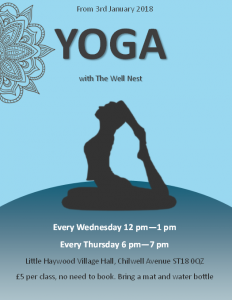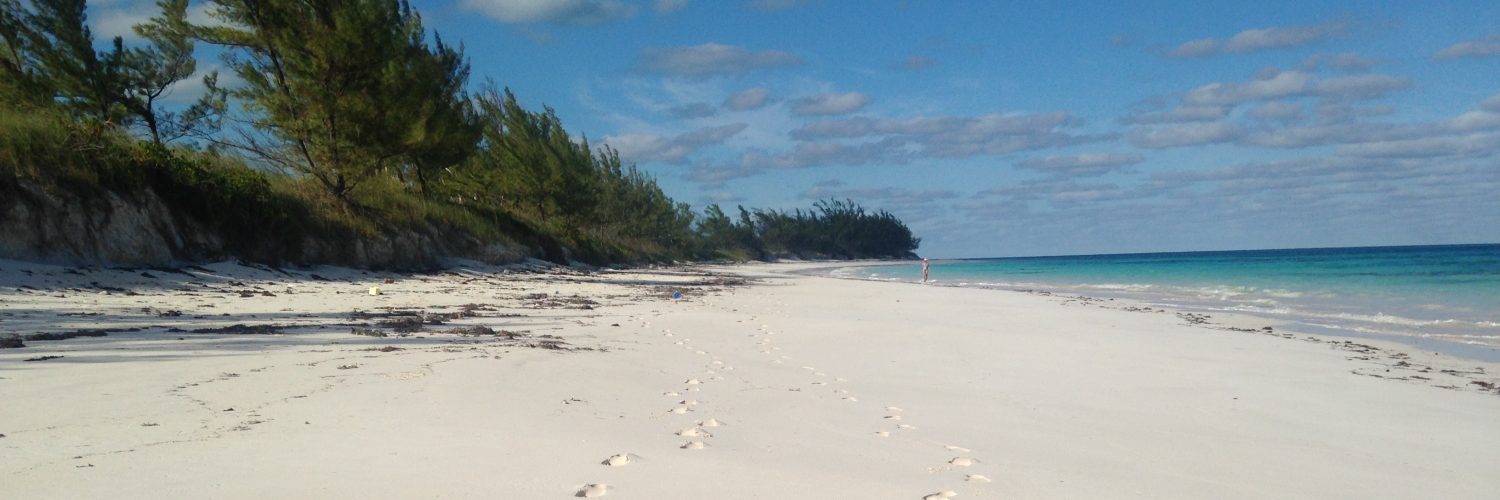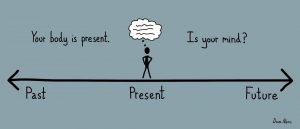I visited a primary school in Warwickshire recently and was pleased to see a display promoting wellbeing through 5 practical steps that are now promoted as basic steps to wellbeing all over the world. The ‘5 ways to wellbeing’ outline simple steps that we can all take to improve our wellbeing and are now advocated by the NHS in order to help people actively take control of their wellbeing. Starting small and building to a holistic approach to wellbeing can help us lessen or avoid more long-term conditions such as depression or anxiety that can effect physical and mental health for many years.
But what is wellbeing exactly? What are we trying to improve? Undoubtedly our mental health and states of mind, but wellbeing is a whole of life experience. An improvement in our overall quality of life and experience through practical, active steps to increase our levels of enjoyment, self-worth, physical and mental health and interactions with others.
This sounds like a big challenge, right? Definitely. But luckily the 5 ways to wellbeing really do work and are a great start to improving wellbeing.
The 5 Ways to Wellbeing
- Connect – There is strong evidence that being around others (friends, family, social groups) not only increases our all-round wellbeing, but also increases our longevity. Talking is the best therapy. You don’t have to share everything with others; start small. Make a meaningful connection instead of living in the digital world all the time. When you ask someone how they are, actually listen and pay attention to the answer. Speak to a stranger or make conversation while waiting in a queue. Try car sharing with a colleague; they might even become a friend.
- Be active – We have all read the decades of evidence that shows being physically active improves our mental health…so why do we still doubt it? Because it’s not easy to get active and stay active. But it’s not hard either. There are small changes we can make on the way to becoming more active and improving wellbeing. Take the stairs instead of the lift. Take a class after work with colleagues or organise a new sporting activity for all work colleagues to try. Go for a walk at lunchtime. Get off the bus a stop earlier and walk to your destination. If you feel like more of a challenge, take up a regular class that is proven to aid concentration, inner peace and help sleep…yoga is the obvious.
- Take notice – The basics of mindfulness; notice your surroundings. Be present in the moment and just ‘be’ instead of always ‘doing’. The only moment that exists is right now, so try to pay more attention to what is really going on instead of living in your head thinking about what has already happened or what might happen. Being mindful increases our awareness and knowledge of the self. If we know what we spend our time thinking about, we can start to change our thought patterns for the better. Living mindfully is a difficult task for the novice, but we can all try small steps. Choose a mindfulness cue; a sound or sight that whenever you hear/see it reminds you to take 60 seconds to be mindful and notice what’s going on in the environment.
- Keep learning – Not only is the mind kept active, but there is the chance for social interaction, being mindful and being active all rolled into one here. Continued learning can enhance self-esteem, motivation and can help you to prioritise goals and your own happiness. This doesn’t have to be a formal class to count as learning. You can try learning a new word each day, try reading the news in a foreign language, listen to classical music, join a book club.
- Give – By giving to others we develop our compassion which in turn increases our compassion for ourselves. Engaging in acts of kindness helps us to gain perspective on our own internal struggles and gain an understanding of the greater good. Giving your time, expertise or just random acts of kindness to others can greatly increase your wellbeing and decrease your attachment to seeking happiness through material gain.
A challenge…
I challenge you to try the 5 Winning Ways to Wellbeing for one week and track how you feel in body and mind. Leave a comment below about your experiences and check back to see my review of a week of Winning Ways to Wellbeing.
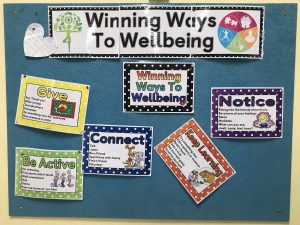
Spacious Back Bends with Ann-Marie Mainprize – Review
My visit to the Om Yoga Show this year provided the chance to try something completely different from the selection of classes available. I usually go for something demanding and full-on so I get a good workout as well as learn from new teachers. As I had managed to book onto two classes this year, I mixed it up with a class on backbends with Ann-Marie Mainprize of Amiyoga in Hull.
The class promised to ‘deepen backbends the Forrest yoga way’ through ‘connecting the core and releasing deep rooted postural tension’ – sounded excellent to me! As I’ve never tried Forrest yoga, that was an added bonus.
I know many people struggle with spinal flexibility and I often advocate core strength as a way of back-bending with confidence, so this sounded like a great way to improve my own knowledge and experience how other teachers focus a class on back-bending safely.
The class focused straight away on opening the front of the body as a way to improve flexibility and stability through the back of the body. We did a lot of strong abdominal work which although simple, was incredibly hard work on the deep core muscles. Lying flat on the back with legs straight in the air we were instructed to press the lower back into the mat and curl up the tail bone – the simple action of lifting in this way (with breath work and holds) was a huge workout for the core.
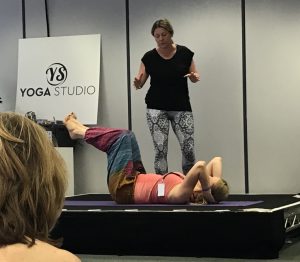
We went on to work dynamically through sun salutation B, some low lunges and lizard pose with a arrow foot stretch (pressing the top of the back foot down into the mat to apply a deeper stretch to the hip flexor) which was bliss but also agony for my tight hip flexors. We visited the ‘engaged glutes or relaxed glutes’ argument when in wheel and bridge – Ann-Marie was on the side of engaged glutes as it provides greater support for the lower back; something I agree with.
An interesting counterpose to all the back bending was to twist out rather than forward bend to reset the spine. Again there is a lot of discussion around this at the moment, but it was the first class I have been to where twist rather than forward bend was taught. I always found that bending the opposite way was counter-productive when deepening spinal flexion…but that forward fold always seems to really loosen the spine as well. The class with Ann-Marie was a real anatomy class – her knowledge was obvious but she made it accessible to all.
The one issue (which I found last year as well) was the poor quality mats provided for the workshops – almost on the edge of dangerous when in wheel as they were so slippery – this is a show issue not a workshop issue however.
I loved the class with Ann-Marie as it was obvious she was used to teaching all levels of students. Her approach was very instructive but helpful (she had three assistants providing hands-on assists throughout). This was a real workshop rather than a yoga class as poses were broken down with anatomy at the forefront. I would definitely recommend this class for yoga teachers.
The next day (and the day after) the muscles either side of my spine were definitely feeling the work that had been done in this class. The simple but effective core strengthening exercises feature regularly in my practice as well now. Definitely worth taking a class with Ann-Marie.
Om Yoga Show Manchester 2018 – Review
I’m a big fan of the Om Yoga Show; this must be the eighth or ninth time I’ve been to the show over the years and the third time visiting the ‘Northern version’ up in Manchester. I enjoyed the show last year and generally find it a much more enjoyable experience than the London version of the show.
Travelling to Manchester is pretty easy from the Midlands by train or car and helpfully, the organisers had kept the venue the same as last year; Event City, right next door to the Trafford Centre (and with free parking woohoo!). I went up on the first day of the show (Friday) and arrived at about 11.30 am and was surprised to see a giant queue to get in, stretching all the way into the car park. I got chatting to a fellow yogi in the queue and she agreed that it hadn’t seemed this busy last year. luckily the queue moved quickly and we got inside to find the hold-up had been due to staff trying to fill and hand out goody bags right in the doorway. Just as we got to the front of the queue we were told the goody bag area was causing a hold-up (no kidding) and so we would have to come back later to collect ours. No problem, as I didn’t fancy carrying the massive paper bag round the show with me.
As it turned out, I could have done with the massive bag to carry all my purchases – I still forget that nobody gives you a carrier bag anymore! The freebies inside this year included samples from BIO-Extracts of face cream, anti-oxidant boost and anti-wrinkle boost and some NOUGHTY leave in conditioner. I gently turned down the free sample of cider vinegar (even though I heard a lively discussion about how it can be effective if applied to acne – not sure which is worse; spots or smelling like vinegar??)
What was on
There was a good variety of stands on offer again this year – about 100 to choose from. This included food and drink, equipment, books, music, clothing, retreats and teacher training, meditation aids, and my personal favourites singing bowls and gongs. I played lots if different singing bowls and had a good chat to the owner of the Moon Karma stand (who was also an ashtangi running yoga retreats in Nepal…that went straight on the to do list). There were also three open classes and two workshop areas and a meditation area. The ticket price of £7.50 for one day entry was a bargain as usual as this allowed access to the show and free entry to all the classes in the open and meditation areas. It also included free entry to Vegan Life Live and the Mind Body Soul Experience.

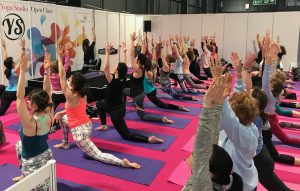
What to do
I started with my usual quick circuit of the stands to find out what was where and who/what I’d like to revisit. Despite the big queues to get in, the show was not overcrowded and it was always easy to see and speak to any of the exhibitors. It was great to see the open classes so well attended. It’s never necessary to queue for more than 5 minutes at the Manchester show to take part in a free class, whereas I have been known to spend 30 minutes waiting at the London show only to be told the class is full.
The open classes this year included traditional Hatha yoga, inversions, singing bowl meditation, chair yoga, crystals, alignment, how to flow, yoga for MS, Kundalini, Kriya yoga, and vinyasa flow to name but a few. There was also a children’s yoga open area. I didn’t have chance to try and open class this year as I had two workshop bookings, but I did stop to watch a few. The Kundalini open class run by KYTA was fascinating; they played some fantastic music which really did help to connect mind and body (and I was only observing!). That one is going on my list for next year. The classes were full, but I didn’t see anyone get turned away so even if you don’t have a workshop booking, it’s worth coming to the show to try a new style of yoga for free. The DRU Yoga area had loads of free taster sessions going on all day as well – I’ve participated in these before and they are well worth the experience. I always think DRU would be the perfect yoga class to get you going in the morning.
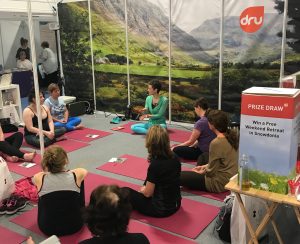
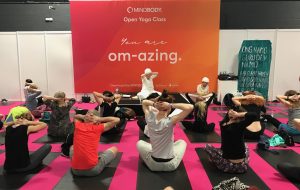
The workshop areas were easy to find and the cost of these longer, intensive classes ranged from £5 – £10 for between 60 and 90 minutes – another great value way to try new things with national or international teachers.
Vegan Life and Mind Body Soul Experience
I briefly popped into Vegan Life Live because I know the food on offer is far superior to any of my own creations. As usual there was a great variety of food on offer as well as clothing, books and workshops to look at. I didn’t spend long in the show, but it was busy inside. I visited Home Kitchen Vegan again for the finest Asian food I have ever tasted!
The MBS Experience looked noticeably depleted this year. There were some familiar stands and faces from previous years, but none of the more interesting meditation, sound experiences and alternative therapies that have previously featured. I’d only recommend a visit to this show if there is a particular Tarot card reader or MBS practitioner that you want to see; otherwise it doesn’t have much to entertain you past the 30 minute mark.
Would I recommend the Om Yoga Show?
Definitely! This show remains a real bargain to visit and with all the free experience areas you can make a full day of it without spending more. If you do want a longer workshop, you can see world leading teachers for a bargain price. There is enough to entertain you for a morning or afternoon if you’re not doing an additional workshop or easily a full day with the extras. I noticed that the variety of clothing stands wasn’t quite as diverse this year but I loved the new additions of gongs and stands with a charitable or education focus.
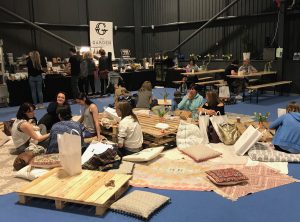
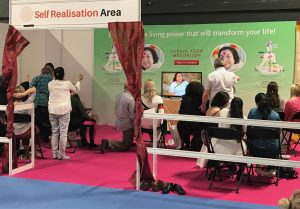
The show desperately needs more areas for meditation and mindfulness and this should be a focus for next year as it was noticeably absent. The noisy atmosphere of the show means that people are often drawn to the quiet areas; and whilst there were places to sit, there were few places to enjoy a peaceful experience and try something new.
The Om Yoga Show is back next in London on 19th – 21st October 2018.
A Mindful Holiday
 We all love to ‘get away from it all’, ‘leave our troubles behind’ and enjoy a holiday (maybe several if we’re lucky) each year. We have a plan of where to go, what to see, what to do and even the places to eat, the number of hours we want to spend on a beach, the sights we want to tick off our ‘to do’ list. For how much of our holidays are we actually present? Really present…paying full attention to what we’re doing in the moment, not thinking about the next thing we’re going to do or how what we did this morning perhaps wasn’t as great as we thought it would be.
We all love to ‘get away from it all’, ‘leave our troubles behind’ and enjoy a holiday (maybe several if we’re lucky) each year. We have a plan of where to go, what to see, what to do and even the places to eat, the number of hours we want to spend on a beach, the sights we want to tick off our ‘to do’ list. For how much of our holidays are we actually present? Really present…paying full attention to what we’re doing in the moment, not thinking about the next thing we’re going to do or how what we did this morning perhaps wasn’t as great as we thought it would be.
We all hope that a trip away will be the ideal escape from work, from stress, from real life. As soon as we recognise that physically moving out of the sphere of our troubles or busyness doesn’t actually rid us of those things, then we can get the most out of our breaks and life generally.
Happiness and peace of mind can occur anywhere at any time, as long as we are in the present moment, paying attention, on purpose.
Paying attention
We can get the most out of our holidays by simply paying full attention to what we’re doing. I enjoy driving in continental Europe, and I think it’s because I pay so much more attention to the task of driving than I normally do. I’m constantly watching, listening, feeling the roads. My focus is fully on the task…and it becomes enjoyable. My mind is not on the destination and what I’m going to do when I get there…it’s just on the very moment of driving.
Pleasure and peacefulness can be found in many places that might usually frustrate us when we’re on holiday. Being stuck in traffic might seem like a waste of time leading to frustration or irritation, but it’s also a great opportunity to people watch, to observe the real life of another country or culture, to take in the sights and sounds of the places we pass through.
How to holiday mindfully
So, you’ve paid a lot of your hard earned money for a break – how do you get the most out of it by using mindfulness? There are a number of top tips for this…
- Walk as often as possible. This could be to get from A to B or to explore an area or just to get to the shops or beach. Leave the car behind. Being on foot gives you endless opportunity to practice mindfulness. Feel the ground under your feet, listen to everything you can hear in the moment; the language, the breeze, music, traffic, life going on right now. Focus on taking in life as it happens in the moment. When you are outdoors under your own steam, there is so much going on to focus your attention on now. If you aren’t able to walk, spend some time sitting outside and let your senses fully take in the environment.
- Use your senses. Don’t just look at things, take a picture and move on. We are very visual by nature and that’s fine, but we have 4 other senses to work with. Listen to what’s going on, what does the city/forest/beach/mountain where you are sound like? Think back to your last holiday – if someone asked you to describe what your destination sounded like, would you be able to do it? Similarly with smells, we only notice the extremes of good or bad. Try to focus in on the smells of the sea air, the leaves and vegetation, the traffic, any animals nearby, food cooking etc. All these things bring you into the present moment so you create stronger memories and find more peace, more genuine ‘escape’ from busyness. The same approach works with taste and touch; use all your senses to bring yourself into the present.
- Use photography differently. In the age of social media, we carefully construct or contrive images to draw the most appreciation from strangers. Try taking photographs of real moments, real life. Take photos that draw your attention to what your senses (other than sight) are experiencing. Create memories of touch sensation, smell, sound etc. In the present moment, it will draw you right into focussing on now, but later, your images will also serve as mindfulness cues that you can rely on in everyday life.
Remember, the core of mindfulness is to be present, whether that’s on holiday or at home. We often feel obliged to pack in as much as possible when we’re on holiday as it only happens a few times a year. Try to move from ‘doing’ to ‘being’. Don’t just pass through life, really live it.
The Importance of Wellness at Work
Workplace wellness programmes are well worth the time and effort invested in them. The success record of companies offering these programmes indicates that an employee who is happy and healthy is more productive and motivated, stays away from work due to illness less often and remains employed with the company for a longer time.
Are you aware of a wellness programme in your workplace? Would you like one?
I’ve worked in a lot of industries and for a lot of companies of different sizes over the years. I haven’t yet encountered any consistency in relation to employee wellness, but I do think that each and every one of the employers I have worked for would undoubtedly say that their employees are the greatest resource and asset to the company.
Most large companies have an IT support team, an estates and facilities team, a grounds maintenance team…all looking after the assets of the business. How well does the Human Resources team look after the employees?
You have probably been offered training, access to conferences and events, possibly social events organised by the company. You may or may not have access to a good annual leave entitlement and additional benefits in the form of discounts or vouchers for products and services…have you ever been offered access to mental health or wellbeing services (importantly, without fear of stigma)?
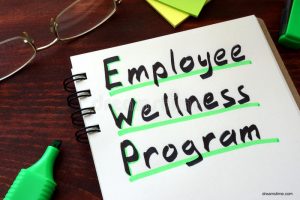
A workplace wellness programme demonstrates to employees that the employer recognises and cares about their health. Let’s face it, we’ve all had time off due to poor health. If there was a programme available to address mental and physical wellbeing, the morale and engagement of staff would increase and time off decreases – it’s win/win.
A great number of illnesses can be reduced or avoided through lifestyle change. As we spend the majority of our time at work, it makes sense that some of the lifestyle changes should be accessible or incorporated into our working life. Access to a quiet and contemplation room, guided meditations, mindfulness courses, relaxation classes, yoga, pilates or Tai Chi classes could make a massive difference to staff wellbeing and productivity. The feeling that you are valued at work makes a real difference – and this isn’t just reflected in the pay slip.
Here are some of the benefits that can come from a workplace wellness programme:
- Improved focus and concentration
- Better physical strength and stamina (less of the aches and pains from sedentary working)
- Increased job satisfaction and a feeling of being valued
- Better relationships with colleagues
- Lower staff turnover (reducing training costs) and greater job satisfaction
- Reduced absenteeism
- Positive corporate image
A wellness programme can be designed to fit around your resources, time, business and employee needs. The benefits to employees and the business can be enormous. Here at The Well Nest we can work with you to offer yoga and mindfulness packages to benefit the physical and mental health of your employees and return those benefits to the business.
To find out more contact [email protected] or visit the Workplace Packages page.
Mountain Meditation
Mountains are often admired from afar for the qualities that they appear to have. Some of these qualities we find beneficial and seek in life: stability, longevity, calm, unwavering and balanced. When we spend some time really contemplating the image of a mountain, we see that it is constant and reliable through the seasons; it is a home for plants and animals; it provides shelter and protection; it abides in tranquility through the centuries.
While it’s often the case that we try not to actively ‘think’ in passive meditation, we can use the visualisation of a mountain in active meditation to assist us in contemplating and finding inner peace. If we spend time on the visualisation we can imagine ourselves taking on the qualities of the mountain.
The Mountain Meditation can be used as a regular practice or as an escape from the rigours of daily life as and when required. I use the Mountain Meditation often as a precursor to sitting with mindfulness of breathing; it acts as a relaxation technique and brings focus before working on expanding awareness.

How to do it…
- Sitting in a comfortable position on a cushion or chair, have the back straight but not tense and the hands resting in the lap.
- Bring the gaze down towards the floor and gently close the eyes.
- Spend a few minutes on breathing meditation/mindfulness of breathing
- Picture in your imagination a mountain – it could be a snowy mountain of the Alps or Himalayas, it could be a forested mountain bathed in sunshine
- Try to bring your image of a mountain into clear focus
- Observe its shape, lofty peak, solid based, gentle or sharply sloping sides, its surface (rocky, smooth, dusty, forested, snowy etc)
- Notice it’s enormous size and how solid and unmoving it is from afar and up close
- Try to bring the qualities of the mountain into your own body – your head becomes the lofty peak, sitting in your chair you are rooted at the base. Your arms become the slopes of the mountain. Feel the sense of uplift from the base of your body projecting through the crown of your head.
- The mountain experiences the force of the seasons – sun, rain, snow, gales. Through it all, it sits unchanging, experiencing all that comes its way
- The mountain never resists, complains or judges – it accepts everything, just being itself
- We can imagine embodying the same unwavering stillness and calmness.
- We can experience the fullness of life and its changes through the seconds, hours, years
- We will experience the changing nature of our minds, our body, the outside world. We will have periods of shade and of light. We can maintain the peace of the mountain throughout.
- Sit in stillness for a while.
- Gently open your eyes and mindfully arise from meditation after around 20 minutes.
How to Sleep Well and Rise Well in the Darker Months
Regulating your body clock can be a difficult task in the winter months as we set off for work in the dark and come home in the dark. It starts to become a struggle to get out of bed and sleep is often disturbed and unrefreshing. Add in the potential for Seasonal Affective Disorder (SAD) and it can feel like a real challenge to find motivation.
Women are often more susceptible to SAD but also more likely to struggle on without any help. The good news is, that there are some simple essential oil remedies that can both relax you in the evening for restful sleep and energise and motivate you for the day time.
Lavender (lavandula augustifolia) 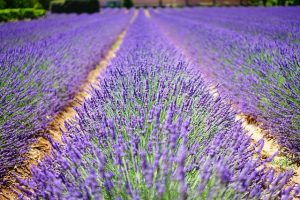
The champion of champions in the aromatherapists kit bag. This wonder plant is very well known for its sleep inducing qualities. It also has the ability to reduce anxiety and emotional stress and is a strong antioxidant making it excellent for pain reduction and skin replenishment. Add a few drops of lavender essential oil to a lavender filled pillow or bag and hang it near the head of the bed. The relaxing, floral aroma will help you drift off.
You can also add a few drops of lavender essential oil to water and using a mist spray bottle, mist your bedding so that the aroma is an encompassing experience.
Lemon (Citrus Limonum)
A long-time favourite of mine, this zesty essential oil is great for enlivening you when the afternoons and dark evenings are dragging and for enhancing concentration. Although lemon is a stimulating oil, it is also calming and works well as a pairing for lavender or on its own. As an extra benefit, lemon is great for calming the digestive system.
Add a few drops to a burner mixed with water to freshen the air after a long day at work (this is when mixing lemon with lavender would be a winning combination) or for use during the day, add a drop or two to a tissue and inhale the refreshing aroma while at your desk or in the car. If you don’t like the fragrance of lemon, you can try grapefruit essential oil instead.
Jasmine (Jasminum Officinale)
Jasmine has a distinctive sweet and flowery fragrance which can be quite heady for some. It does however, have great properties for relieving the blues that often come when the darker months are dragging on. When vaporised (by placing in a burner with some water) Jasmine stimulates the autonomic nervous system and enlivens and awakens the mind and body. It is also excellent as a room fragrance and can be mixed with water for use in a mist spray bottle.
Rose (Rosa Damascena) 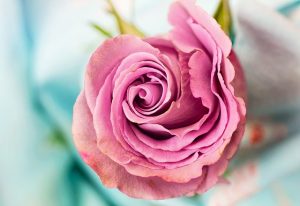
Known for its strong but pleasing floral fragrance, rose essential oil is excellent for calming anxiety or stress and is a friend to those who struggle to regulate sleeping in the darker months. Inhaling rose essential oil through vaporisation (by placing in a burner along with some water) will relax the mind and body. Not a scent to be used when looking for alertness, the properties of this oil are all about relaxation. It has a beneficial uplifting effect on the mood, but really helps sooth the body into a good night’s sleep.
Sandalwood (Santalum Album)
Sandalwood has been used for many hundreds of years for its antidepressant and anti-anxiety qualities. It is also recognised for its properties of focusing the mind. By adding a few drops of sandalwood to a tissue and inhaling throughout the day, it can help to improve the mood and attentiveness but also calm and relax the body.
Sandalwood makes an excellent room fragrance when vaporised, but has the same beneficial properties when burnt in the form of cones or incense sticks. The fragrance can be a little overpowering for some, so as an essential oil it should be used sparingly.
Mental Health Awareness with 1st Armitage Scout Group
The importance of raising awareness and recognition of mental health conditions is gaining a lot of support in the press and is high on the agenda for employers and health groups. It was great to hear that the Scout Troop Leaders at Armitage were exploring the theme of mental health with the Scouts over a number of weeks. Different activities were tried by the Scouts to encourage stress reduction and ways of helping to improve mental health.
I was invited along to teach a yoga class for the Scouts including some relaxation and meditation. There were around 30 Scouts ranging from 10 – 16 years old and all very eager to get started with yoga! I gave an introduction telling the Scouts how yoga can help improve mental health through concentration in the present moment, release of endorphins and breath control.
We tried some breathing exercises to lower the heart rate and increase oxygen circulation before going into a class themed with animal postures to keep the Scouts engaged throughout. After some downward dogs, dolphins, camels, tigers and flamingos thrown into the mix, we settled down to a final relaxation of counted breath. Surprisingly, quiet came to the room as everyone concentrated on their relaxation.
The session was a big success with the Scouts and the Troop Leaders who joined in, and gave a valuable taste of an alternative method for improving mental health.
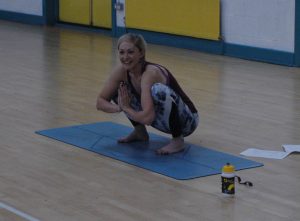
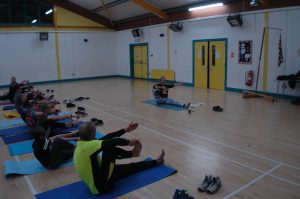
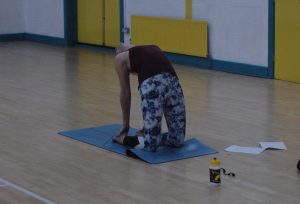
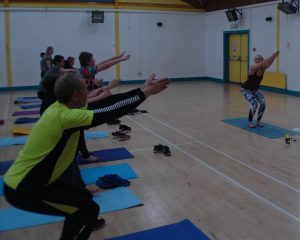
Mindfulness Courses Now Available
Mindfulness is a practice of widening our awareness and insight so that we can live in the present moment without judgment. The ability to watch our minds and the busyness within as an observer rather than through grasping onto thoughts, allows us to experience a greater freedom and peace of mind. The skills of mindfulness can be used in daily life to reduce stress and anxiety, be more productive and develop better relationships at work and at home and lead to a greater sense of physical and mental wellbeing.
The following mindfulness courses are now available in Stafford:
Introduction to Mindfulness—single session course (£25)
Available on the following dates from 6 pm—8 pm:
Tuesday 6th February
Tuesday 13th February
Eight Session Mindfulness Practitioner Course (Introductory offer price £130)
Course starts on Tuesday 27th February and runs weekly with one home practice week at week 5. Each session runs from 6 pm—7.30 pm.
Courses are held in a town centre location with nearby parking. Course materials will be provided.
For more information, visit the Mindfulness tab
New Year Yoga
What are you doing for yourself this year?
Come and join us for New Year Yoga! Starting on Wednesday 3rd January 2018 at 12 pm
